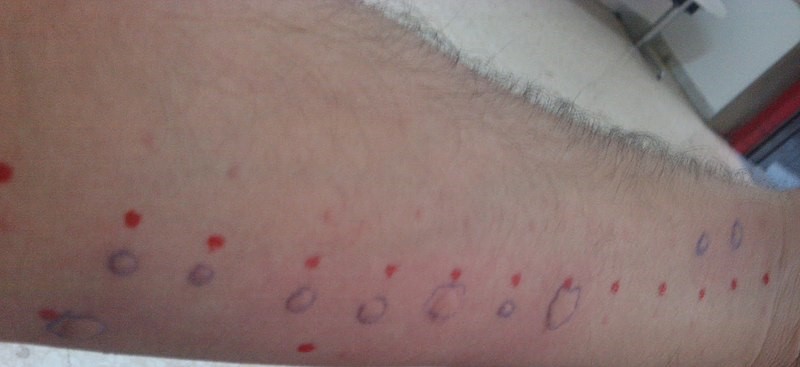11.7 Medical Specialists, Diagnostic Testing, and Procedures Related to the Lymphatic and Immune Systems
Medical Specialists
Immunology (im-yŭ-NOL-ŏ-jē) is the study of disorders of the immune system. An immunologist (ĭm-ū-NŎL-ō-jĭst) is a physician who specializes in the study and treatment of immune system disorders.
An allergist (AL-ĕr-jist) is a physician who specializes in the study and treatment of allergies.
Read more about careers in allergy and immunology on the American Academy of Allergy Asthma and Immunology’s Careers web page.
Diagnostic Testing
Lymph Node Biopsy
During a lymph node biopsy, lymph node tissue is removed for examination under a microscope by a pathologist to diagnose medical conditions like infection or cancer. There are different types of lymph node biopsies, including the following[1]:
- Needle biopsy (NĒ-dĭl BĪ-ŏp-sē): After applying local anesthesia, a radiologist inserts a needle into a lymph node using ultrasound or CT scan to find the node.
- Laparoscopic lymph node biopsy (lăp-ăr-ŏ-SKŎ-pĭk limf nōd BĪ-ŏp-sē): After the patient is placed under general anesthesia, a small tube with a light and camera is inserted through a small incision. One or more other incisions will also be made for the insertion of tools to locate and remove the lymph node.
- Open lymph node biopsy (Ō-pĕn limf nōd BĪ-ŏp-sē): Surgery is performed to remove all or part of a lymph node, typically performed if the lymph node is large enough to be felt on physical exam.
- Sentinel lymph node biopsy (SĔN-tĭ-nĕl limf nōd BĪ-ŏp-sē): For some cancers, a sentinel lymph node biopsy is performed to find the best lymph nodes to biopsy. A tiny amount of a radioactive tracer or dye is injected in the area of the tumor. The tracer or dye flows into the nearest lymph nodes, the first lymph nodes to which a cancer may spread. These lymph nodes, called the sentinel nodes, are removed and analyzed.
Skin Testing for Allergies
Skin testing for allergies is performed by an immunologist or allergist to identify allergens in Type I hypersensitivity. In skin testing, allergen extracts are injected into the patient’s epidermal layer of the skin. The development of a wheal at the site of injection indicates a positive result. Based on the test results, individuals should avoid allergens that trigger a Type I hypersensitivity reaction. See Figure 11.11[2] for an image of allergy testing with wheals indicating positive responses to an allergen.

Tissue Typing
Tissue typing (TĬSH-ū tī-pĭng) ensures that an organ from a donor will be compatible with its recipient. The process starts with identifying the unique human leukocyte antigens (hyū-măn lū-kō-sīt ĂN-tĭ-jĕnz) (HLAs) for the organ donor and recipient, either from blood or tissue. HLAs are an important part of the immune system’s response to foreign substances and act as a barcode to distinguish “self” from “non-self” — the latter resulting in rejection of the transplanted organ.[3]
To date, more than 35,000 variations of the HLA protein have been identified. This makes it extremely difficult to find HLA-matched donors for transplant recipients. Half of a person’s antigens are inherited from their mother and half from their father, so the more similar the antigen patterns are from two people, the more likely it is that those people are related. Identical twins have the same pattern, and brothers and sisters have a 1-in-4 chance of having an identical match.[4]
Procedures Related to the Lymphatic and Immune System
Splenectomy
Splenectomy (splĕ-NĔK-tŏ-mē) refers to surgical removal of a diseased or damaged spleen. Because of the important role the spleen plays in the immune system, individuals who have had a splenectomy are at increased risk of infection for the remainder of their lives.
Tonsillectomy
The tonsils help protect against infections. However, abnormally large tonsils may be removed if they contribute to recurrent cases of tonsillitis (tŏn-sĭl-Ī-tĭs) or breathing problems, especially at night. During a tonsillectomy (tŏn-sĭl-ĔK-tŏ-mē), the patient is placed under general anesthesia and the tonsils are removed by a surgeon. The adenoid, located behind the nasal cavity, may also be removed during this surgery and is referred to as an adenoidectomy (ăd-ĕ-noid-ĔK-tŏ-mē).[5]
- Medline Plus. (2022). Lymph node biopsy. https://medlineplus.gov/ency/article/003933.htm ↵
- “Another_allergy_skin_testing.jpg” by Ismael Olea is licensed under CC BY 4.0 ↵
- Brunk-Young, J. (2021, April 30). What is tissue typing for transplant? The Ohio State University Wexner Medical Center. https://wexnermedical.osu.edu/blog/tissue-typing ↵
- Brunk-Young, J. (2021, April 30). What is tissue typing for transplant? The Ohio State University Wexner Medical Center. https://wexnermedical.osu.edu/blog/tissue-typing ↵
- Medline Plus. (2023). Tonsillectomy. https://medlineplus.gov/ency/article/003013.htm ↵
